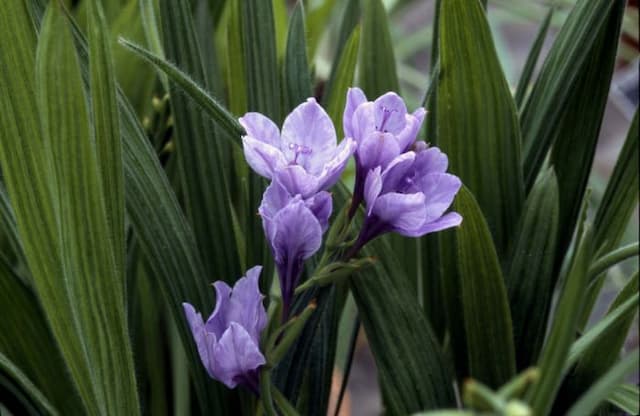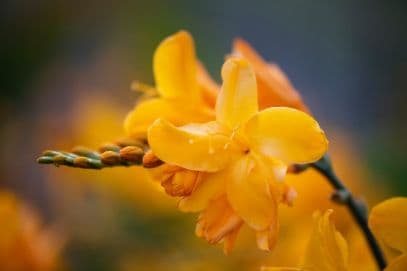Tall Bearded Iris Iris 'Oh! Susannah' (TB)

ABOUT
Iris 'Oh! Susannah' showcases a stunning display of large, ruffled flowers that are sure to be the highlight of any garden during its bloom time. The blooms exhibit a rich, golden-yellow hue that can range from a deep, sun-kissed color to a pale buttery tone, often with slight variations and gradations of color that add depth and visual interest. These vibrant yellow flowers are usually adorned with a contrasting deep maroon or brownish 'beard'—a fuzzy line that runs along the middle of each of the flower's lower petals, known as falls. In addition to the falls, the flowers possess upright petals called standards, which may maintain the same golden-yellow color or can sometimes present a slightly lighter shade, creating an intriguing color play that is delightful to observe. The foliage of Iris 'Oh! Susannah' consists of long, slender, sword-shaped leaves that are a grayish-green, providing a striking architectural aspect to the plant. The leaves emerge from thick, creeping rhizomes that sit at or just below the soil surface, forming dense clumps that add to the lush appearance of the foliage. The plant's overall structure presents a fan-like appearance, with the leaves gracefully arching out from the center of the clump. The combination of the showy blooms, the contrasting beard, and the elegant foliage make Iris 'Oh! Susannah' a sought-after variety that's both eye-catching and classic in its garden appeal. This plant brings a burst of brilliant color and a touch of sophistication to any planting scheme. Whether used as a focal point, grouped in masses, or lined along borders, Iris 'Oh! Susannah' is a testament to the beauty and grandeur that irises can offer to the discerning gardener.
About this plant
 Names
NamesFamily
Iridaceae
Synonyms
Tall Bearded Iris, Bearded Iris
Common names
Iris 'Oh! Susannah' (TB).
 Toxicity
ToxicityTo humans
The Tall Bearded Iris, commonly known as 'Oh! Susannah', is considered mildly toxic if ingested. The rhizomes, or underground stems, contain compounds that can cause gastrointestinal discomfort. Symptoms of poisoning may include nausea, vomiting, abdominal pain, and diarrhea. Handling the plant can sometimes cause skin irritation due to its light toxicity.
To pets
The Tall Bearded Iris, known simply as the Bearded Iris, is also toxic to pets such as dogs and cats if ingested. The rhizomes are the most toxic part, and ingestion can lead to symptoms such as salivation, vomiting, drooling, lethargy, and diarrhea. Severe cases might result in dehydration due to excessive vomiting and diarrhea. It's important to prevent pets from chewing on any part of the plant.
 Characteristics
CharacteristicsLife cycle
Perennials
Foliage type
Deciduous
Color of leaves
Green
Flower color
Yellow
Height
3 feet (91 cm)
Spread
1 foot (30 cm)
Plant type
Bulb
Hardiness zones
3-9
Native area
North America
Benefits
 General Benefits
General Benefits- Ornamental Value: Iris 'Oh! Susannah' has striking flowers that add beauty and visual interest to gardens and landscapes.
- Drought Tolerance: Once established, this type of iris is quite tolerant of drought, making it suitable for regions with lower water availability.
- Low Maintenance: Irises generally require minimal care, making them a good choice for gardeners seeking plants that do not need constant attention.
- Attracts Pollinators: The flowers attract bees, butterflies, and other pollinators, which are vital for the health of the ecosystem.
- Long Bloom Period: This iris variety has a relatively long flowering period, providing color in the garden during its blooming season.
- Hardiness: Typical of tall bearded irises, 'Oh! Susannah' is hardy and can withstand varying climatic conditions once established.
- Design Versatility: Suitable for a wide range of garden designs, including borders, beds, and as accent plants.
- Propagation Ease: It can be easily propagated through division, allowing gardeners to multiply their plants and share with others.
- Seasonal Interest: In addition to its bloom time, the foliage of irises adds texture and greenery throughout the season.
 Medical Properties
Medical PropertiesThis plant is not used for medical purposes.
 Air-purifying Qualities
Air-purifying QualitiesThis plant is not specifically known for air purifying qualities.
 Other Uses
Other Uses- The tall bearded iris can be used in fabric dyeing, with different parts of the plant creating a variety of dyes—roots for warm yellow tones, and petals for purples and lavenders.
- Iris fibers, particularly from the leaves, can be spun into a natural thread or yarn that is then used for crafting and textiles.
- These irises can play a role in water purification by being planted in constructed wetlands and helping to absorb contaminants from wastewater.
- The blooms can be pressed and included in floral arrangements, decorative bookmarks, and artwork for their intricate designs and vibrant colors.
- As a natural insect repellent, the tall bearded iris can be planted to help deter certain insects from the garden due to its strong fragrance.
- The sturdy stems of the tall bearded iris can be used as natural supports or stakes for other, more fragile plants in the garden.
- The petals of the tall bearded iris can be used in potpourri mixes to add color and a subtle fragrance to a room.
- Floral designers can use the unique shape and colors of the iris for modern and avant-garde flower arrangements, using their striking appearance to create focal points.
- Photographers and artists may utilize the tall bearded iris as a subject for botanical illustration and photography due to its dramatic form and hues.
- The seeds of the iris, shaped like beads, can be incorporated into jewelry-making for an organic and natural touch to necklaces and bracelets.
Interesting Facts
 Feng Shui
Feng ShuiThe Iris is not used in Feng Shui practice.
 Zodiac Sign Compitability
Zodiac Sign CompitabilityThe Iris is not used in astrology practice.
 Plant Symbolism
Plant Symbolism- Hope: The iris often symbolizes hope, embodying the expectation of positive outcomes and better times ahead.
- Wisdom: Due to its regal appearance and historic associations, the iris carries a connotation of wisdom, providing insight and guidance.
- Faith: The iris is also seen as a representation of faith, demonstrating a deep belief in the unseen and spiritual.
- Courage: Its robust nature and ability to thrive in various conditions allow the iris to stand as a symbol of courage, especially in challenging circumstances.
- Purity: The elegant form and clean lines of the iris flower can symbolize purity, often in a spiritual or moral sense.
 Water
WaterTall Bearded Iris 'Oh! Susannah' should be watered deeply and infrequently to encourage strong root growth, approximately every 7 to 10 days during the active growing season, provided there is no significant rainfall. Ideally, apply about one inch of water each time, which for an average garden area would translate to around half a gallon per square foot over that period. It's crucial to avoid overwatering as it can lead to rhizome rot. Ensure the soil is well-drained and allow the topsoil to dry out slightly between waterings. Watering frequency should be decreased after blooming ends and during the dormant period in winter.
 Light
LightTall Bearded Iris 'Oh! Susannah' thrives best in conditions where it receives at least six hours of direct sunlight each day. A spot with full sun exposure ensures vigorous growth and optimal flowering. If possible, choose a location that provides morning sun and some afternoon shade in hotter climates to protect the blooms.
 Temperature
TemperatureTall Bearded Iris 'Oh! Susannah' can tolerate a wide range of temperatures but performs optimally when day temperatures are between 55°F and 85°F. It's hardy and can survive winter lows down to -40°F, making it resilient to harsh conditions. The ideal temperatures for this iris type would be moderate, with the plant experiencing no issues in the typical temperature fluctuations of temperate zones.
 Pruning
PruningTall Bearded Iris 'Oh! Susannah' requires pruning mainly to remove spent flowers and to tidy up the plant by cutting back on brown leaves. This pruning, done immediately after blooming, prevents the iris from wasting energy on seed production. Additionally, in late summer or fall, cut foliage down to about 6 inches to prepare the plant for winter and prevent overwintering pests and diseases. It's important to sterilize your cutting tools before use to prevent the spread of disease.
 Cleaning
CleaningAs needed
 Soil
SoilThe Tall Bearded Iris 'Oh! Susannah' thrives in well-draining soil with moderate fertility and a pH slightly on the acidic to neutral side, around 6.8 to 7.0. A good soil mix might contain loamy garden soil, compost, and coarse sand to enhance drainage.
 Repotting
RepottingTall Bearded Iris 'Oh! Susannah' typically does not require frequent repotting. If clumps become overcrowded, usually every 3 to 5 years, they should be divided and replanted in fresh soil to encourage continued blooming.
 Humidity & Misting
Humidity & MistingTall Bearded Iris 'Oh! Susannah' is tolerant of a wide range of humidity levels but prefers conditions that are not excessively moist, mirroring its natural habitat, which has moderate humidity.
 Suitable locations
Suitable locationsIndoor
Ensure ample light, good airflow, and avoid overwatering.
Outdoor
Plant in full sun, well-drained soil, and maintain even moisture.
Hardiness zone
3-9 USDA
 Life cycle
Life cycleThe life of the Iris 'Oh! Susannah', also known as Tall Bearded Iris, begins with seed germination, which typically occurs in late spring, where seeds develop in a cold, moist environment, simulating winter conditions. After germination, the seedlings grow into juvenile plants, producing their first leaves and establishing a small root system. As the plants mature, they develop a robust rhizome, the bulb-like underground stem characteristic of irises, along with a larger root system and increase in foliage. The Tall Bearded Iris reaches its flowering stage in late spring to early summer, displaying its showy, large, and fragrant blooms, which are usually a deep yellow or gold color in this cultivar. After flowering, the plant enters a period of vegetative growth and energy storage in the rhizome to prepare for the next flowering season. Upon the end of the growing season, the iris enters dormancy, with foliage dying back, and it remains dormant through the winter until the cycle begins again with the warmth of spring.
 Propogation
PropogationPropogation time
Late summer
The Iris 'Oh! Susannah', also known as a Tall Bearded Iris, is typically propagated by division. This is best done late in the summer, after the flowering has finished, usually every 3 to 5 years to maintain plant vigor and health. To propagate, carefully dig up the clump of iris rhizomes, which are the thick, fleshy roots that store energy for the plant. Using a sharp knife, divide the rhizomes by cutting them into pieces, making sure that each section has at least one fan of leaves and a portion of the roots. Trim the leaves to about a third of their original height, or around 4 to 6 inches (approximately 10 to 15 centimeters), to reduce transpiration and give the plant a better chance to establish. Lastly, replant the divisions, setting the rhizome so the top is slightly exposed to the sun, in well-draining soil and spaced about 12 to 24 inches apart (30 to 60 centimeters). This allows enough space for the iris to grow and ensures optimal flowering in subsequent years.









